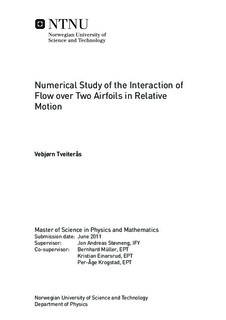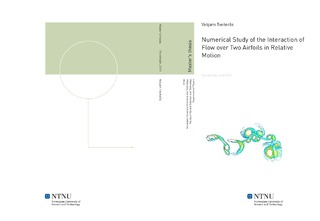| dc.contributor.advisor | Støvneng, Jon Andreas | nb_NO |
| dc.contributor.advisor | Müller, Bernhard | nb_NO |
| dc.contributor.advisor | Einarsrud, Kristian | nb_NO |
| dc.contributor.advisor | Krogstad, Per-Åge | nb_NO |
| dc.contributor.author | Tveiterås, Vebjørn | nb_NO |
| dc.date.accessioned | 2014-12-19T13:17:00Z | |
| dc.date.available | 2014-12-19T13:17:00Z | |
| dc.date.created | 2011-09-15 | nb_NO |
| dc.date.issued | 2011 | nb_NO |
| dc.identifier | 441350 | nb_NO |
| dc.identifier | ntnudaim:6559 | nb_NO |
| dc.identifier.uri | http://hdl.handle.net/11250/246512 | |
| dc.description.abstract | Computational fluid dynamics (CFD) was be used to investigate aspects of interaction of flow over two airfoils in relatie motion in detail.%Problem statement2D tandem airfoil setups were studied, where the leading airfoil was performing an oscillating motion in the vertical direction while the trailing airfoil was kept stationary. The NACA 0012 and the S809 airfoils were considered.%ApproachAnsys Fluent v13.0 was used as the CFD solver, and Gambit v2.4.6 was employed for grid generation. All simulations were transient at a Reynolds number of either 2*10^4 (laminar flow) or 3*10^6 (turbulent flow). The Transition SST turbulence model was chosen to model turbulence, and Fluent's sliding grid technique was used to achieve the relative motion between the airfoils.%ResultsThe tandem setup was found able to outperform a single airfoil for similar conditions. The presence of a trailing airfoil did not significantly affect the leading airfoil's performance, whereas it did affect the wake structures significanlty. The suction peak near the nose of the airfoil was found to be the most important factor determining the airfoil's propulsive efficiency. Therefore, leading edge vortex (LEV) shedding was found to be of higher importance than trailing edge vortex (TEV) shedding when airfoil performance was concidered.The asymmetric S809 airfoil provided similar results as the symmetric NACA 0012 airfoil. However, the NACA 0012 airfoil achieved slightly higher propulsive efficiencies for the cases investigated, indicating that a symmetric airfoil is desired for flapping airfoil setups. For the tandem setup the highest propulsive efficienies were 0.766 and 0.742 for the NACA 0012 airfoil and the S809 airfoil, respectively. Both peaks were found at k = 0.3 and h = 0.6 (Sr = 0.11) for the leading airfoil. A maximum thrust coefficient of 2.32 was found for the tandem S809 airfoil setup at k = 1.5 and h = 0.5 (Sr = 0.48).The Strouhal number was found to be an important describing parameter, but additional information about the reduced frequency or the oscillating amplitude was needed in order to fully describe the setup. | nb_NO |
| dc.language | eng | nb_NO |
| dc.publisher | Institutt for fysikk | nb_NO |
| dc.subject | ntnudaim:6559 | no_NO |
| dc.subject | MTFYMA fysikk og matematikk | no_NO |
| dc.subject | Teknisk fysikk | no_NO |
| dc.title | Numerical Study of the Interaction of Flow over Two Airfoils in Relative Motion | nb_NO |
| dc.type | Master thesis | nb_NO |
| dc.source.pagenumber | 132 | nb_NO |
| dc.contributor.department | Norges teknisk-naturvitenskapelige universitet, Fakultet for naturvitenskap og teknologi, Institutt for fysikk | nb_NO |

